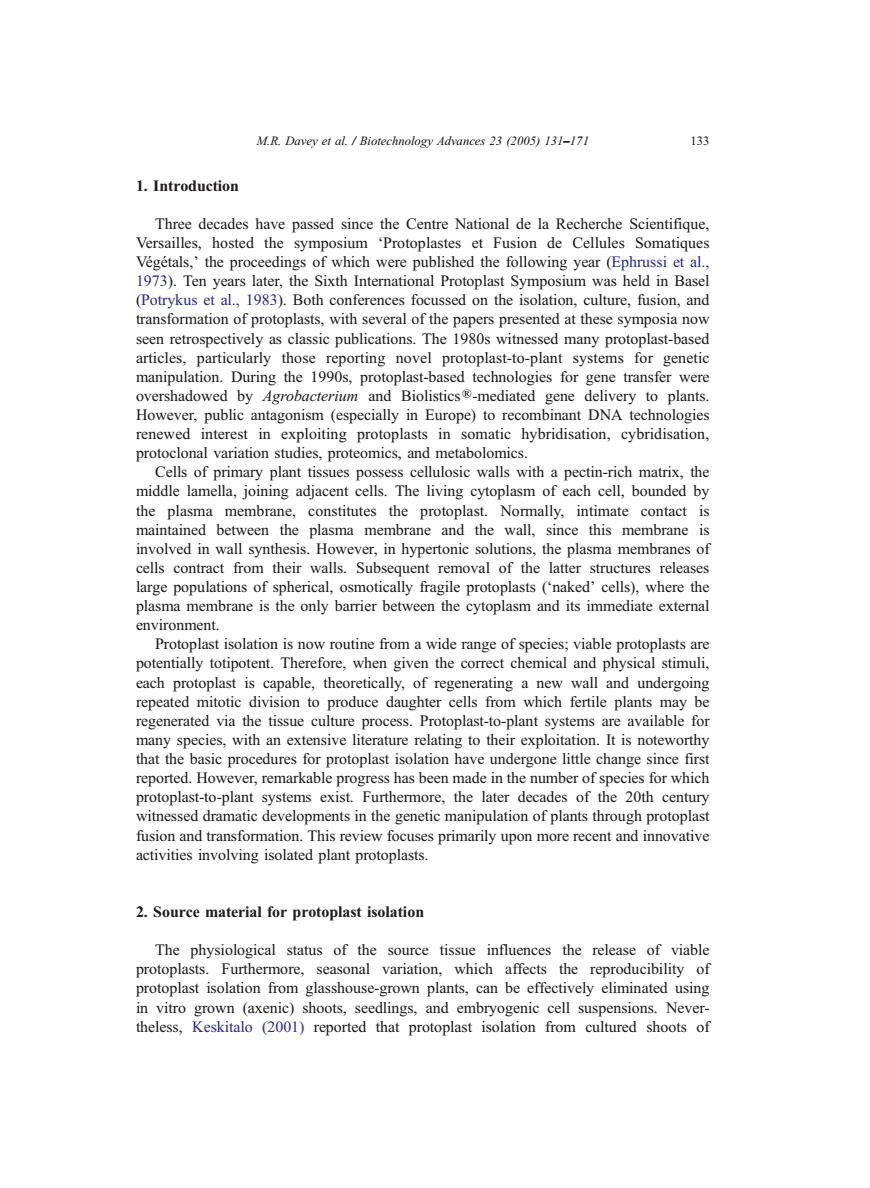正在加载图片...

M.R.Davey et al.Biotechnology Advances 23 (2005)131-171 133 1.Introduction Three decades have passed since the Centre National de la Recherche Scientifique, Versailles,hosted the symposium 'Protoplastes et Fusion de Cellules Somatiques Vegetals,'the proceedings of which were published the following year (Ephrussi et al., 1973).Ten years later,the Sixth International Protoplast Symposium was held in Basel (Potrykus et al.,1983).Both conferences focussed on the isolation,culture,fusion,and transformation of protoplasts,with several of the papers presented at these symposia now seen retrospectively as classic publications.The 1980s witnessed many protoplast-based articles,particularly those reporting novel protoplast-to-plant systems for genetic manipulation.During the 1990s,protoplast-based technologies for gene transfer were overshadowed by Agrobacterium and Biolistics -mediated gene delivery to plants. However,public antagonism (especially in Europe)to recombinant DNA technologies renewed interest in exploiting protoplasts in somatic hybridisation,cybridisation, protoclonal variation studies,proteomics,and metabolomics. Cells of primary plant tissues possess cellulosic walls with a pectin-rich matrix,the middle lamella,joining adjacent cells.The living cytoplasm of each cell,bounded by the plasma membrane,constitutes the protoplast.Normally,intimate contact is maintained between the plasma membrane and the wall,since this membrane is involved in wall synthesis.However,in hypertonic solutions,the plasma membranes of cells contract from their walls.Subsequent removal of the latter structures releases large populations of spherical,osmotically fragile protoplasts ('naked'cells),where the plasma membrane is the only barrier between the cytoplasm and its immediate external environment. Protoplast isolation is now routine from a wide range of species;viable protoplasts are potentially totipotent.Therefore,when given the correct chemical and physical stimuli, each protoplast is capable,theoretically,of regenerating a new wall and undergoing repeated mitotic division to produce daughter cells from which fertile plants may be regenerated via the tissue culture process.Protoplast-to-plant systems are available for many species,with an extensive literature relating to their exploitation.It is noteworthy that the basic procedures for protoplast isolation have undergone little change since first reported.However,remarkable progress has been made in the number of species for which protoplast-to-plant systems exist.Furthermore,the later decades of the 20th century witnessed dramatic developments in the genetic manipulation of plants through protoplast fusion and transformation.This review focuses primarily upon more recent and innovative activities involving isolated plant protoplasts. 2.Source material for protoplast isolation The physiological status of the source tissue influences the release of viable protoplasts.Furthermore,seasonal variation,which affects the reproducibility of protoplast isolation from glasshouse-grown plants,can be effectively eliminated using in vitro grown (axenic)shoots,seedlings,and embryogenic cell suspensions.Never- theless,Keskitalo (2001)reported that protoplast isolation from cultured shoots of1. Introduction Three decades have passed since the Centre National de la Recherche Scientifique, Versailles, hosted the symposium dProtoplastes et Fusion de Cellules Somatiques Ve´ge´tals,T the proceedings of which were published the following year (Ephrussi et al., 1973). Ten years later, the Sixth International Protoplast Symposium was held in Basel (Potrykus et al., 1983). Both conferences focussed on the isolation, culture, fusion, and transformation of protoplasts, with several of the papers presented at these symposia now seen retrospectively as classic publications. The 1980s witnessed many protoplast-based articles, particularly those reporting novel protoplast-to-plant systems for genetic manipulation. During the 1990s, protoplast-based technologies for gene transfer were overshadowed by Agrobacterium and BiolisticsR-mediated gene delivery to plants. However, public antagonism (especially in Europe) to recombinant DNA technologies renewed interest in exploiting protoplasts in somatic hybridisation, cybridisation, protoclonal variation studies, proteomics, and metabolomics. Cells of primary plant tissues possess cellulosic walls with a pectin-rich matrix, the middle lamella, joining adjacent cells. The living cytoplasm of each cell, bounded by the plasma membrane, constitutes the protoplast. Normally, intimate contact is maintained between the plasma membrane and the wall, since this membrane is involved in wall synthesis. However, in hypertonic solutions, the plasma membranes of cells contract from their walls. Subsequent removal of the latter structures releases large populations of spherical, osmotically fragile protoplasts (dnakedT cells), where the plasma membrane is the only barrier between the cytoplasm and its immediate external environment. Protoplast isolation is now routine from a wide range of species; viable protoplasts are potentially totipotent. Therefore, when given the correct chemical and physical stimuli, each protoplast is capable, theoretically, of regenerating a new wall and undergoing repeated mitotic division to produce daughter cells from which fertile plants may be regenerated via the tissue culture process. Protoplast-to-plant systems are available for many species, with an extensive literature relating to their exploitation. It is noteworthy that the basic procedures for protoplast isolation have undergone little change since first reported. However, remarkable progress has been made in the number of species for which protoplast-to-plant systems exist. Furthermore, the later decades of the 20th century witnessed dramatic developments in the genetic manipulation of plants through protoplast fusion and transformation. This review focuses primarily upon more recent and innovative activities involving isolated plant protoplasts. 2. Source material for protoplast isolation The physiological status of the source tissue influences the release of viable protoplasts. Furthermore, seasonal variation, which affects the reproducibility of protoplast isolation from glasshouse-grown plants, can be effectively eliminated using in vitro grown (axenic) shoots, seedlings, and embryogenic cell suspensions. Nevertheless, Keskitalo (2001) reported that protoplast isolation from cultured shoots of M.R. Davey et al. / Biotechnology Advances 23 (2005) 131–171 133